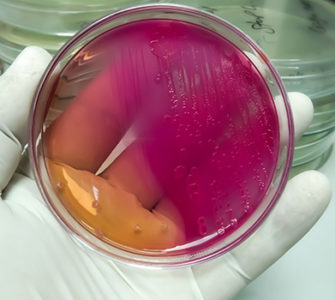Three-pronged E. coli strategy to help cut losses, improve profitability
Managing Escherichia coli infection in commercial poultry flocks has to be tackled on three fronts to help cut losses and improve profitability, says Allan Ball, of the Slate Hall Veterinary Practice in the UK.
E. coli is a part of the normal gut flora in chickens, and not all E. coli are detrimental to birds. However, pathogenic types of E. coli can overwhelm the bird’s immune system, resulting in septicemia. “When we see birds with E. coli, it is normally a generalized infection, affecting multiple organ systems,” he said in an interview with Poultry Health Today.
E. coli is ubiquitous in the environment, and birds will always be exposed to some level of the pathogen. However, based on his experience, Ball believes the threat of E. coli is greater than ever today due to intensified poultry farming, whether it’s a broiler, broiler-breeder or layer operation.
“I am convinced the overall level of bacterial challenge is [higher] in an intensive production system” compared to chickens kept in small flocks, he said. For producers, this means they have to do more to manage the E. coli challenge.
Consequences and losses
Birds can contract an E. coli infection in a variety of ways that include contact with contaminated surfaces or floor, feeding and drinking systems. Breeder birds can transmit E. coli onto egg shells, ultimately infecting hatching chicks.
In broilers, the highest E. coli challenge tends to be during the first week of life, Ball continued. The challenge to parent broiler-breeders tends to be during the height of production — around 28 to 33 weeks — when their stress level is highest.
The results can be economically severe. In a 2013 Dutch study of only E. coli-associated peritonitis in four layer and two broiler-breeder flocks, total losses including the cost of antibiotics were estimated to be €0.4 million for the layer sector and €3.3 million for the meat sector.1
There are other losses that producers don’t always consider. “People always look at the losses on the farm, but I do not think that there is enough emphasis put on losses at the processing plant,” which include condemnations and lost carcass weight, he said.
In the Dutch study, there was a mean total weight loss at processing of 0.2 kg for the layer flocks and 0.5 kg for broiler-breeder flocks associated with E. coli peritonitis.
E. coli management strategy
To help reduce losses from E. coli, Ball recommends a combination of improved farm management, “high biosecurity” and vaccination.
“Reducing management deficiencies will ultimately have the biggest impact in reducing the bacterial challenges in birds,” he said. Good farm hygiene is critical and so is biosecurity to prevent E. coli as well as other pathogens from being tracked onto the farm by visitors, workers and equipment.
Ball emphasized the importance of husbandry aimed at reducing bird stress, which will help prevent the immune system from being compromised and enable producers to optimize their production systems.
Birds must be kept comfortable and able to express their natural behaviour. “Making sure birds have access to feed, water, fresh air, light are the basic management procedures that will stand tall when it comes to facing E. coli challenges,” he said, noting that enrichment factors used in intensive systems can help reduce stress.
Because the use of antibiotics in food animals has been reduced, producers will want to consider using probiotics and favorable, naturally occurring bacteria that colonize the gut and stabilize the intestinal tract of the birds. Ball believes these alternatives to antibiotics can have a beneficial effect and be a valuable component of E. coli management.
Vaccination
Vaccination is the third part of the E. coli-management strategy Ball describes. It’s not a magic bullet and should be considered as a preventive measure for use alongside biosecurity and good farm management, but it can help improve profitability by minimizing the impact of E. coli.
“It doesn’t mean that if you vaccinate the birds you can neglect all the other management procedures,” he cautioned.
For best results, vaccination has to be carried out before there is an E. coli field challenge instead of waiting for E. coli to colonize birds. Birds need time for their immune system to develop an immune response. In addition, if E. coli infection progresses from the acute stage to the sub-acute and chronic stage, the response to vaccination won’t be as good, he said.
Ball has used Poulvac® E. coli, a modified, non-reactive live vaccine developed by Zoetis that’s administered to chickens by coarse spray or in drinking water. It’s indicated for immunization of broilers, future layer/breeders and for turkeys to reduce mortality and lesions associated with E. coli serotype 078.
In a cross-protection study, however, the severity of airsacculitis was reduced in broilers that received the vaccine and were challenged with one of three non-078 serotypes.2 In broilers vaccinated with Poulvac® E. coli then challenged with three E. coli isolates from Thailand, mortality was reduced and weight gain improved compared to controls, according to Zoetis.3
A risk analysis can help broiler producers determine if they can recoup costs for vaccinating against E. coli; for future layer and breeder flocks, the cost benefit is easier to substantiate, Ball said.
The vaccination plan for E. coli will also vary among farms. The use of a live vaccine early in life for future breeders, for instance, may need to be followed with an inactive E. coli vaccine during the production cycle, he added.
Although an E. coli vaccination program has to take returns into consideration, it should be viewed as part of a broader health program intended to improve bird health and productivity as well as profitability.
“Because that is what it comes down to — improving profitability on the farm,” Ball said.
1. Landman W, et al. The incidence and economic impact of the Escherichia coli peritonitis syndrome in Dutch poultry farming. Avian Pathol. 2015 Oct;44(5):370-8.
2. Cookson K., et al. In: Proceedings of the 58th Western Poultry Disease Conference; 2009.
3. Cookson K., et al. In: Proceedings of the 59th Western Poultry Disease Conference; 2010.
Posted on October 11, 2017

















